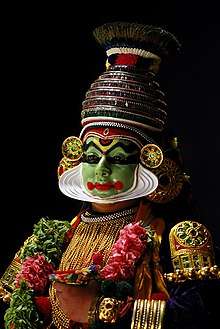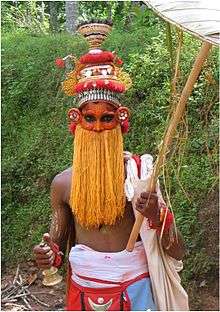Onam
Onam is an annual [4][5][6] holiday and festival celebrated in Kerala, India. It is also a harvest festival, and falls on the 22nd nakshatra Thiruvonam in the Malayalam calendar month of Chingam, which in Gregorian calendar overlaps with August–September.[7][8] According to legends, the festival is celebrated to commemorate King Mahabali, whose spirit is said to visit Kerala at the time of Onam.[9][8]
| Onam, Thiruvonam[1] | |
|---|---|
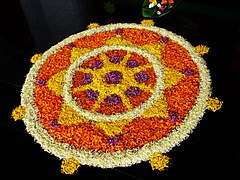 Flower Rangoli, called pookalam, is an Onam tradition | |
| Observed by | Malayalis as religious and cultural festival, Kerala state |
| Significance | Harvest festival[2][3] |
| Observances | Sadya, Thiruvathira Kali, Puli Kali, Pookalam, Ona-thallu, Thrikkakarayappan, Onathappan, Tug of War, Thumbi Thullal, Onavillu, Kazhchakkula, Athachamayam, and Vallamkali. |
| Date | Chingam (August/September) |
| 2019 date | Sun 1 Sep to Fri 13 Sep |
| 2020 date | Sat 22 Aug to Wed 2 Sep |
| Frequency | Annual |
| Related to | Balipratipada |
Onam is a major annual event for Malayali people in and outside Kerala. It is a harvest festival, one of three major annual Hindu celebrations along with Vishu and Thiruvathira, and it is observed with numerous festivities.[10] Onam celebrations include Vallam Kali (boat races), Pulikali (tiger dances), Pookkalam (flower Rangoli), Onathappan (worship), Onam Kali, Tug of War, Thumbi Thullal (women's dance), Kummattikali (mask dance), Onathallu (martial arts), Onavillu (music), Kazhchakkula (plantain offerings), Onapottan (costumes), Atthachamayam (folk songs and dance), and other celebrations.[11] It is the New Year day for Malayalis.[12][13]
Onam is the official state festival of Kerala with public holidays that start four days from Uthradom (Onam eve).[14] Major festivities take place across 30 venues in Thiruvananthapuram,[15] capital of Kerala. It is also celebrated by Malayali diaspora around the world.[8] Though a Hindu festival, non-Hindu communities of Kerala participate in Onam celebrations considering it as a cultural festival.[8][16][14] However, some non-Hindus in Kerala denounce its celebration as a cultural event because they consider it as a religious festival.[17][18]
Significance
Onam is an ancient Hindu[4][5] festival of Kerala that celebrates rice harvest.[9][6] The significance of the festival is in Hindu legends, of which two are more common.
Mahabali legend
According to the Hindu mythology, Mahabali was the great- great-grandson of a Brahmin sage named Kashyapa, the great-grandson of demonic dictator, Hiranyakashipu, and the grandson of Vishnu devotee Prahlada. This links the festival to the Puranic mythology of Prahlada of Holika fame in Hinduism, who was the son of Hiranyakashipu. Prahlada, despite being born to a demonic Asura father who hated Vishnu, rebelled against his father's persecution of people and worshipped Vishnu. Hiranyakashipu tries to kill his son Prahlada, but is slain by Vishnu in his Narasimha avatar, Prahlada is saved.[19]
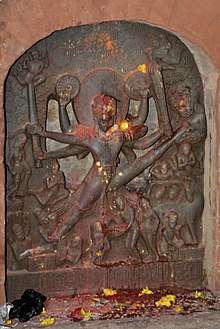
Prahlada's grandson, Mahabali, came to power by defeating the gods (Devas) and taking over the three worlds. According to Vaishnavism mythology, the defeated Devas approached Vishnu for help in their battle with Mahabali.[9] Vishnu refused to join the gods in violence against Mahabali, because Mahabali was a good ruler and his own devotee. He, instead, decided to test Mahabali's devotion at an opportune moment. Mahabali, after his victory over the gods, declared that he would perform a Yajna (homa sacrifices/rituals) and grant anyone any request during the Yajna. Vishnu took the avatar – his fifth[20] – of a dwarf boy called Vamana and approached Mahabali. The king offered anything to the boy – gold, cows, elephants, villages, food, whatever he wished. The boy said that one must not seek more than one needs, and all he needed was "three paces of land." Mahabali agreed.[9][21]
Vamana grew to an enormous size, and covered everything Mahabali ruled over in just two paces. For the third pace, Mahabali offered his head for Vishnu to step on, an act that Vishnu accepted as evidence of Mahabali's devotion.[9] Vishnu granted him a boon, by which Mahabali could visit again, once every year, the lands and people he previously ruled. This revisit marks the festival of Onam, as a reminder of the virtuous rule and his humility in keeping his promise before Vishnu. The last day of Mahabali's stay is remembered with a nine-course vegetarian Onasadya feast.[9][22]
According to Nanditha Krishna, a simpler form of this legend, one without Mahabali, is found in the Rigveda and the Vedic text Shatapatha Brahmana where a solar deity is described with powers of Vishnu. This story likely grew over time, and is in part allegorical, where Bali is a metaphor for thanksgiving offering after a bounty of rice harvest during monsoon, and Vishnu is the metaphor of the Kerala sun and summer that precedes the Onam.[23] According to Roshen Dalal, the story of Mahabali is important to Onam in Kerala, but similar Mahabali legends are significant in the region of Balia and Bawan in Uttar Pradesh, Bharuch in Gujarat, and Mahabaleshwar in Maharashtra. The story is significant not because Mahabali's rule ended, but it emphasizes the Hindu belief in cyclical nature of events, that no individual, no ruler and nothing lasts forever, except the virtues and self-understanding that overcomes all sorrow.[24]
Parashurama legend
An alternate legend behind Onam relates to Parashurama, an incarnation of Vishnu who is credited in Hindu mythology to have created the Western Ghats from the southern tip of Kerala, Karnataka, Goa and up to Maharashtra.[25] According to this legend, Vishnu got upset with the kings and the warrior caste who were constantly at war and were arrogant over others.[25]
Vishnu took the avatar of Parashurama, or "Rama with an axe" and also known as Rama Jamadagyna, in the era of King Kaartavirya. This king persecuted and oppressed the people, the sages and the gods.[25] One day, the king came to the hermitage of Parashurama and his mother Renuka, where while Parashurama was away, the king without permission took away the calf of their cow. When Parashurama returned, he felt the injustice of the king, called him to war, and killed the king and all his oppressive warriors. At the end, he threw the axe, and wherever it fell, the sea retreated, creating the land of Kerala and other coastal western parts of Indian subcontinent.[25] Another version states that Parashurama brought Namboodiri Brahmins to southwestern parts of India, by creating a mini-Himalaya-like mountain range with his axe. The Onam festival, according to this legend, celebrates Parashurama's creation of Kerala by marking those days as the new year.[26]
The legend and worship of Parashurama is attested in texts and epigraphs dated to about the 2nd century CE.[25]
Cultural festival
Onam is a "popular major Hindu festival in Kerala", states Christine Frost, but one that is also celebrated by Orthodox Christians with "much zest alongside Hindus".[27] The festival is celebrated in Kerala churches by Christians, with local rituals, according to Selvister Ponnumuthan.[14] These traditions, according to Selvister Ponnumuthan, start with the lighting of Nilavilakku, an arati that includes waving of flowers (pushparati) over the Bible, eating the Onam meal together with the Hindus as a form of "communion of brothers and sisters of different faiths".[14] The significance of these practices are viewed by some Kerala Christians as a form of integration with Hindus, mutual respect and sharing a tradition.[14]
Most Muslims join the festivities in Kerala and celebrate "Hindu festivals such as Onam".[28]
Muslim reformists have called on other Muslims to refrain from taking part in the festival.[17] For example, a Kerala-based Salafi preacher has called Onam as haram (wrong and forbidden).[29] In 2019 , another Muslim religious speaker caused controversy over his statement that Muslims should not celebrate the festivals of other religions like Onam.[30]Some Muslim Indian politicians light traditional vilakku (oil lamps), while others have refused to light these lamps at Onam events declaring it to be a Hindu tradition and against the teachings of Islam. Muslim daily newspapers and other publications have condemned Muslim ministers who participate in Onam traditions.[17][31][29] However some Muslims observe Onam anyway, considering its celebrations and rituals as a cultural practice.[18][32]
According to Ritty A. Lukose, Onam is generally considered as a Hindu festival, one that is culturally inclusive within the "secular lexicon" of Hinduism.[33] In recent years, however, it has undertaken a political tone. In one case, students group affiliated with Hindu nationalism in Kerala objected when a Muslim played the role of Mahabali.[33] While the student group did not attack the Muslim, they targeted and protested against the local organizer when alternate Hindus are available to play that role.[33] According to Lukose, this incident shows how "the cultural figure of King Mahabali, understood as Hindu, tolerant and inclusive" into an "exclusively Hindu one".[33]
Celebrations, rituals and practices
Onam falls in the month of Chingam, which is the first month according to the Malayalam Calendar. The celebrations mark the Malayalam New Year, are spread over ten days, and conclude with Thiruvonam. The ten days are sequentially known as Atham, Chithira, Chodhi, Vishakam, Anizham, Thriketa, Moolam, Pooradam, Uthradam and Thiruvonam. The first and the last day are particularly important in Kerala and to Malayalee communities elsewhere.[9]
The Atham day is marked with the start of festivities at Vamanamoorthy Thrikkakara temple (Kochi). This Vishnu temple is considered as the focal centre of Onam and the abode of Mahabali, with the raising of the festival flag.[34] Parades are held, which are colourful and depict the elements of Kerala culture with floats and tableaux.[35]
Other days have diverse range of celebrations and activities ranging from boat races, cultural programs, sports competitions, dance events, martial arts, floral Rangoli – pookkalam, prayers, shopping, donating time or food for charity to spending time with family over feasts. Men and women wear traditional dress. The Kerala sari or Kasavu sari is particularly wore on this day.[36]
Athachamayam
The Onam celebrations across the state, starts off with a grand procession at Thrippunithura near Kochi called Atthachamayam, also referred to as Thripunithura Athachamayam. The parade features elephants marching, drum beats and other music, folk art forms, floats and colorfully dressed people with masks.[37] In Kerala's history, the Kochi king used to head a grand military procession in full ceremonial robes from his palace to the Thrikkakara temple, meeting and greeting his people. In contemporary times, this a state-supported event.[35][38]
The parade floats traditionally feature scenes from epics such as the Mahabharata and the Ramayana. Additionally, some floats include themes from the Bible as well as current themes thereby highlighting unity and harmony.[39]
The procession path historically has been from Tripunithura to the Vamanamoorthy Temple in Thrikkakara, Ernakulam district. The temple is dedicated to Vishnu in his Vamana (dwarf) avatar. After arrival at the temple, the marchers offer a prayer.[39]
Pookkalam (Flower Carpets)
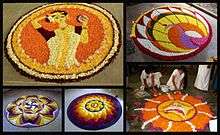
.jpg)
The floral carpet, known as Onapookkalam or just Pookkalam,[40] is made out of the gathered blossoms with several varieties of flowers of differing tints pinched up into little pieces to design and decorate patterns on floor, particularly at entrances and temple premises like a flower mat. Lamps are arranged in the middle or edges. It is a work of religious art, typically the team initiative of girls and women, who accomplish it with a delicate touch and a personal artistic sense of tone and blending.[41] When completed, a miniature pandal (umbrella) hung with little festoons is erected over it.[42] The pookkalam is similar to Rangoli which is made of powders of various colors and is popular in North India.
The traditional ritual of laying pookkalam (floral carpet) starts on Atham day. The pookkalam on this day is called Athapoo, and it is relatively small in size. The size of the pookkalam grows in size progressively with each day of the Onam festival. Only yellow flowers will be used on Atham with only one circular layer made and the design is kept simple. Statues or figurines of Mahabali and Vamana are also installed at the entrance of each house on this day.
Traditionally, Atthapookalams included flowers endemic to Kerala and the Dashapushpam (10-flowers), but nowadays all varieties of flowers are used.[43] Earthen mounds, which look somewhat like square pyramids, representing Mahabali and Vamana are placed in the dung-plastered courtyards in front of the house along with the Pookalam, and beautifully decorated with flowers. All over Kerala, Pookalam competitions are a common sight on Onam day.[35]
Music and dance
Traditional dance forms including Thiruvathira, Kummattikali, Pulikali, Thumbi Thullal, Onam Kali and others. Thiruvathira Kali is a women's dance performed in a circle around a lamp. Kummattikali is a colourful-mask dance. In Thrissur, festivities include a procession consisting of caparisoned elephants surrounded by Kummatikali dancers. The masked dancers go from house to house performing the colorful Kummattikali. Onam Kali is a form of dance where players arrange themselves in circles around a pole or tree or lamp, then dance and sing songs derived from the Ramayana and other epics.
Kathakali dance is also commonly performed during this time, with dancers enacting famous mythological legends.[45] A famous venue for this is at Valluvanad which is associated with the growth of Kathakali,[46] and Cheruthuruthy, where Kerala Kalamandalam is located.
Pulikali: tiger dance
Pulikali, also known as Kaduvakali is a common sight during Onam season. This dance showcases performers painted like tigers in bright yellow, red and black, who dance to the beats of instruments like Chenda and Thakil. This folk art is mainly performed in the cultural district of Thrissur and thousands pour into the city to be a part of this art.
Performances of the ritual worship dance, Theyyam, are given during the Onam season.[11] In this, Mahabali is played by the Onathar. Its variations include characters such as Oneswaran and Onapottan.
At the Thrikkakara temple, every day of the festival showcases one or more of these activities including Kathakali, Thiruvathira, Chakyar Koothu, Ottam Thullal, Patakam, Onam songs, and percussion instrument shows.[45][47] The Onasadya here is grand in scale, and is attended by over ten thousand people from all religions and faiths.[48] Festivities include Puli Kali (masked leopard dance) and traditional dance forms like Kaikotti Kali which are performed in various functions. The official Government celebrations start on this day with heavy illuminations in Thiruvananthapuram, Kochi and Kozhikode along with fireworks.
Most cities in Kerala, such as the political, commercial and cultural capitals, Thiruvananthapuram, Kochi and Thrissur, are lit up with lights and fabulous displays of fireworks. Sumptuous Onam Sadya feasts are prepared. In Thrikkakara temple, a mega-feast is conducted, which is open to the public and is attended by more than twenty thousand people.[49]
Vallamkali: boat race

The Vallamkali (the snake boat race) is another event that is synonymous with Onam. Well-known races include the Aranmula Uthrattadhi Boat Race and the Nehru Trophy Boat Race. Numerous oarsmen row huge snake-shaped boats. Men and women come from far and near to watch and cheer the snake boat race through the water. This event is particularly featured on the Pampa River, considered sacred and Kerala equivalent of Ganges River.[9]
As a tribute to the traditional snake boat race, a similar snake boat race is also held by the Malayali diaspora in Singapore annually during Onam at the Jurong Lake.[50]
Onam Sadya


The Onam sadya (feast) is another indispensable part of Thiruvonam,[42] and almost every Keralite attempts to either make or attend one. The Onasadya reflects the spirit of the season and is traditionally made with seasonal vegetables such as yam, cucumber, ash gourd and so on.[51] The feast is served on plantain leaves and consists of nine courses, but may include over two dozen dishes, including (but not limited to):[52] Chips (especially Banana chips), Sharkaraveratti (Fried pieces of banana coated with jaggery),[53][54] Pappadam, various vegetable and soups such as Injipuli (also called PuliInji), Thoran, Mezhukkupuratti, Kaalan, Olan, Avial, Sambhar, Dal served along with a small quantity of ghee, Erisheri, Molosyam, Rasam, Puliseri (also referred to as Velutha curry), Kichadi (not to be confused with Khichdi) and Pachadi (its sweet variant), Moru (buttermilk or curd mixed with water), Pickles both sweet and sour, and coconut chutney. The feast ends with a series of dessert called Payasam (a sweet dish made of milk, sugar, jaggery, and other traditional Indian savories) eaten either straight or mixed with ripe small plantain. The curries are served with rice, usually the 'Kerala Matta' parboiled rice preferred in Kerala.[53]
In hotels and temples, the number of curries and dishes may go up to 30. The importance of the feast to the Kerala's Onam celebration culture is captured in the famous Malayalam proverb "Kaanam Vittum Onam Unnanam" which means "One must have the Onam lunch even by selling one's property, if need be."[42] The Travancore-style Onasadya is renowned to be the most disciplined and tradition-bound.[53]
Post Onam celebrations
Normally, the largest chunk of Onam celebrations ends by Thiruvonam. However, the two days following Thiruvonam are also celebrated as Third and Fourth Onam. The third Onam, called Avvittom marks the preparations for King Mahabali's return ascension to heavens. The main ritual of the day is to take the Onathappan statue which was placed in the middle of every Pookkalam during the past 10 days and immerse it in nearby rivers or sea. The Pookkalam will be cleaned and removed after this ritual.
Other customs
People buy and wear new clothes for the occasion of Onam, and this tradition is called the Onakkodi.
During the Onam, Keralite Hindus install an image of Thrikkakara Appan or Onatthappan (Vishnu in the form of Vamana) in their home[55] just as Hindus install images or murtis of Lord Ganesha on the Ganesha Chaturthi festival elsewhere.
Many lamps are lit in Hindu temples of Kerala during this celebration.[56] A palmyra tree is erected in front of temples and surrounded with a wooden balustrade and covered with dry palmyra leaves.[56] It is lit with a torch and burned to ashes to signify that King Mahabali went to Patala as a sacrifice.[56]
The swing is another integral part of Onam, especially in the rural areas. Young men and women, decked in their best, sing Onappaatt, or Onam songs, and rock one another on swings slung from high branches.
Onam season is often associated with creativity as weavers and potters go for excess production to cater to increased demands for their products during the season, especially in North Kerala regions of Kannur and Kasargod. Handloom fairs are an integral part of the spirit of Onam festivities these days.[11]
In some parts of Kerala, people indulge in various games and dances during and post-Thiruvonam. These are known as Onakkalikal. These include competitions such as Ox races (Maramadimatsaram), Uriyady, food-eating competitions, Pookalam competitions etc.in a special month
Outside India
Onam is also celebrated by the worldwide Malayali diaspora. Celebrations are notable in the United Arab Emirates, Singapore, United Kingdom, New Zealand, Australia, United States[50][57][58], and in France (Paris, Marseille)
See also
- Onathallu or Avittathallu
References
- Government of Kerala, Official Holidays 2017
- Ann Morrill (2009). Thanksgiving and Other Harvest Festivals. Infobase Publishing. pp. 46, 49–50. ISBN 978-1-4381-2797-2.
- Chopra, Prabha (1988). Encyclopaedia of India. p. 285.
Onam – Most important festival of Kerala; held in Chingam (August–September)
- Editors of Encyclopaedia Britannica (1974). The New Encyclopaedia Britannica. Encyclopaedia Britannica. p. 534. ISBN 978-0-85229-290-7.CS1 maint: extra text: authors list (link), Quote: "Onam, Hindu festival in Kerala State, India."
- Elaine Chase; Grace Bantebya-Kyomuhendo (2015). Poverty and Shame: Global Experiences. Oxford University Press. p. 312. ISBN 978-0-19-968672-8., Quote: "Onam (Hindu festival)"
- Caroline Osella; Filippo Osella (2006). Men and Masculinities in South India. Anthem Press. p. 174. ISBN 978-1-84331-232-1., Quote: "The 2000 Onam (Hindu festival) special edition of..."
- Onam Festival, The Society for Confluence of Festivals of India (2015)
- Cush, Denise; Robinson, Catherine; York, Michael (2012). Encyclopedia of Hinduism. Routledge. pp. 573–574. ISBN 978-1135189792.
Despite its Hindu associations, Onam is celebrated by all communities.
- J. Gordon Melton (2011). Religious Celebrations: An Encyclopedia of Holidays, Festivals, Solemn Observances, and Spiritual Commemorations. ABC-CLIO. p. 659. ISBN 978-1-59884-206-7.
- Peter J. Claus; Sarah Diamond; Margaret Ann Mills (2003). South Asian Folklore: An Encyclopedia. Taylor & Francis. p. 454. ISBN 978-0-415-93919-5.
- M. Nazeer (10 August 2010). "The abiding lore and spirit of Onam". The Hindu. Retrieved 26 September 2013.
- Filippo Osella; Caroline Osella (2013). Islamic Reform in South Asia. Cambridge University Press. p. 152. ISBN 978-1-107-27667-3., Quote: "Onam [Malyali Hindu new year] (...)"
- Denise Cush; Catherine Robinson; Michael York (2012). Encyclopedia of Hinduism. Routledge. pp. 573–574. ISBN 978-1-135-18978-5.
- Selvister Ponnumuthan (1996). The Spirituality of Basic Ecclesial Communities in the Socio-religious Context of Trivandrum/Kerala, India. Gregorian Press. pp. 210–212. ISBN 978-88-7652-721-0.
- "Onam Celebrations".
- Malayali Muslim man celebrates Onam after a preacher calls the festival 'haram', India Today, Shreya Biswas (12 September 2016);
Mahabali comes calling, The Hindu, Neeti Sarkar (5 September 2014) - Filippo Osella; Caroline Osella (2013). Islamic Reform in South Asia. Cambridge University Press. p. 152. ISBN 978-1-107-27667-3.
- Malayali Muslim man celebrates Onam after a preacher calls the festival 'haram', India Today, Shreya Biswas (12 September 2016)
- J. Gordon Melton (2011). Religious Celebrations: An Encyclopedia of Holidays, Festivals, Solemn Observances, and Spiritual Commemorations. ABC-CLIO. pp. 400–402. ISBN 978-1-59884-206-7.
- Michael D. Coogan (1998). The Illustrated Guide to World Religions. Oxford University Press. p. 152. ISBN 978-0-19-521997-5.
- Nanditha Kirshna (2009). Book of Vishnu. Penguin Books. pp. 58–59. ISBN 978-81-8475-865-8.
- Gopal, Madan (1990). K.S. Gautam (ed.). India through the ages. Publication Division, Ministry of Information and Broadcasting, Government of India. p. 74.
- Nanditha Krishna (2009). Book of Vishnu. Penguin Books. pp. 58–61. ISBN 978-81-8475-865-8.
- Roshen Dalal (2010). Hinduism: An Alphabetical Guide. Penguin Books. pp. 229–230. ISBN 978-0-14-341421-6.
- Nanditha Krishna (2009). Book of Vishnu. Penguin Books. pp. 65–69. ISBN 978-81-8475-865-8.
- Nanditha Krishna (2009). Book of Vishnu. Penguin Books. pp. 67–68. ISBN 978-81-8475-865-8.
- Christine Mangala Frost (2017). The Human Icon: A Comparative Study of Hindu and Orthodox Christian Beliefs. James Clarke Company Limited, Cambridge, UK. p. 46. ISBN 978-0-227-90612-5.
- Journal of Kerala Studies. 38. University of Kerala. 2011. p. 100. Retrieved 1 January 2020., Quote: "Most of the Muslims celebrate Hindu festivals like Onam, Divali etc; actively participating in the Hindu festivals without any religious feelings but as occasions to rejoice with friends"
- Sunni outfits slam Muneer, The Times of India (9 September 2016);
Kerala salafi preacher says Onam, Christmas haram, The Times of India (18 July 2016) - "Muslims should diplomatically keep off Onam-Christmas celebrations:Religious speaker makes controversial statement". Retrieved 17 April 2020.
- Osella, Filippo; Osella, Caroline (2007). "Islamism and Social Reform in Kerala, South India" (PDF). Modern Asian Studies. Cambridge University Press. 42 (2–3): 330–331. doi:10.1017/s0026749x07003198.
- Mahabali comes calling, The Hindu, Neeti Sarkar (5 September 2014)
- Ritty A. Lukose (2009). Liberalization's Children: Gender, Youth, and Consumer Citizenship in Globalizing India. Duke University Press. pp. 182–183, context: 179–183. ISBN 0-8223-9124-4.
- "Myth, mystique and traditions of Onam". The Hindu. Kochi, India. 21 August 2014.
- PTI (14 August 2010). "'Athachamayam' Festivities held at Tripunithura". The Hindu. Retrieved 17 September 2013.
- "Say it in gold and off-white". The Hindu. Kochi, India. 14 September 2016.
- Thripunithura Athachamayam, Kerala Tourism, Government of Kerala
- "And Onam is here, officially". The Hindu. Kochi, India. 14 September 2016.
- Athachamayam: a festival of generations, Athachamayam, Trippunithura Municipality (2015)
- Ann Morrill (2009). Thanksgiving and Other Harvest Festivals. Infobase Publishing. pp. 49–50. ISBN 978-1-4381-2797-2.
- Stephen P. Huyler (1994). Painted Prayers: Women's Art in Village India. St Martins Press. p. 191. ISBN 978-0-8478-1809-9.
- Team MetroPlus. "The feel of Onam". The Hindu. Retrieved 17 September 2013.
- "'Athappookalam' losing traditional verve". The Hindu. 1 September 2009. Retrieved 17 September 2013.
- D. Appukuttan Nair (1993). Kathakali, the Art of the Non-worldly. Marg Publications. p. 47. ISBN 978-81-85026-22-0.
- "Thiruvonam celebrated with enthusiasm". The Hindu. 11 September 2011. Retrieved 17 September 2013.
- Vinu Vasudevan (9 May 2013). "Majestic portrayals". The Hindu. Retrieved 17 September 2013.
- "Ritual lunch marks Onam at Thrikkakara". The Hindu. 24 August 2010. Retrieved 17 September 2013.
- "Grandeur marks Onam celebrations at Thrikkakkara temple". The Hindu. 11 September 2011. Retrieved 17 September 2013.
- "Thrikkakara temple gears up for Onam". The Hindu. Chennai, India. 24 August 2013.
- "Onam celebrated in S'pore". Asia One news. 7 September 2012. Archived from the original on 23 December 2016. Retrieved 30 December 2012.
- "Onam Festival". Retrieved 24 July 2018.
- "Kerala gets ready for 26 dish Onam sadya". 4 September 2014.
- N. Satyendran (10 August 2010). "Onam on a leaf". The Hindu. Retrieved 14 September 2016.
- "Sarkara varatti recipe". Cheena Chatti. Retrieved 30 October 2015.
- "Flowers, pookkalam and Onam". The Hindu. 13 September 2013. Retrieved 17 September 2013.
- Genealogy Of The South Indian Deities By Bartholomaeus Ziegenbalg, Daniel Jeyaraj. p. 179
- "Onam celebrations in Dubai to have traditional flair". The Khaleej Times. 15 August 2015. Retrieved 30 December 2015.
- Shveta Pathak (10 September 2011). "Keralites in the UAE celebrate Onam". Gulf News. Retrieved 30 December 2012.
External links

